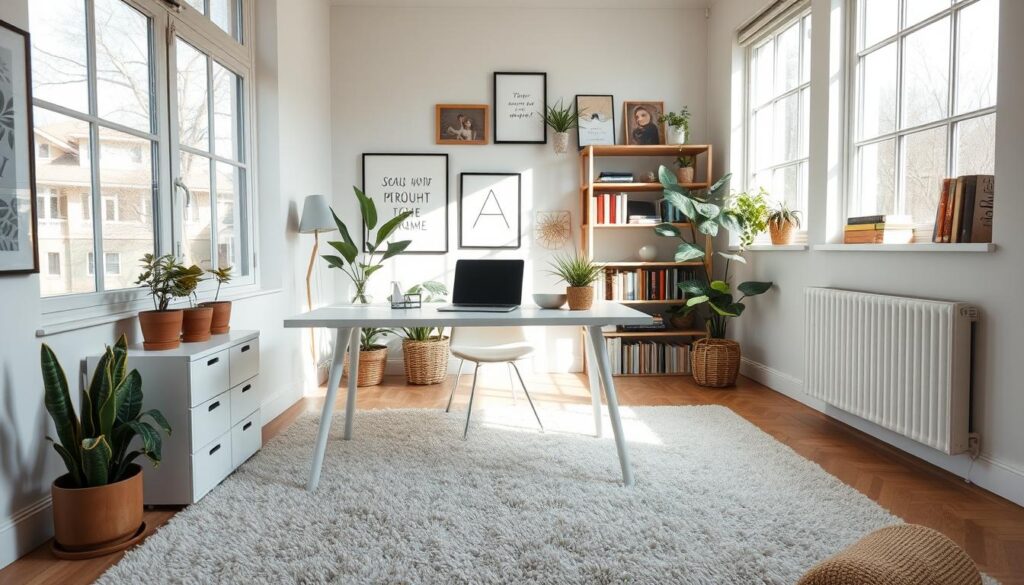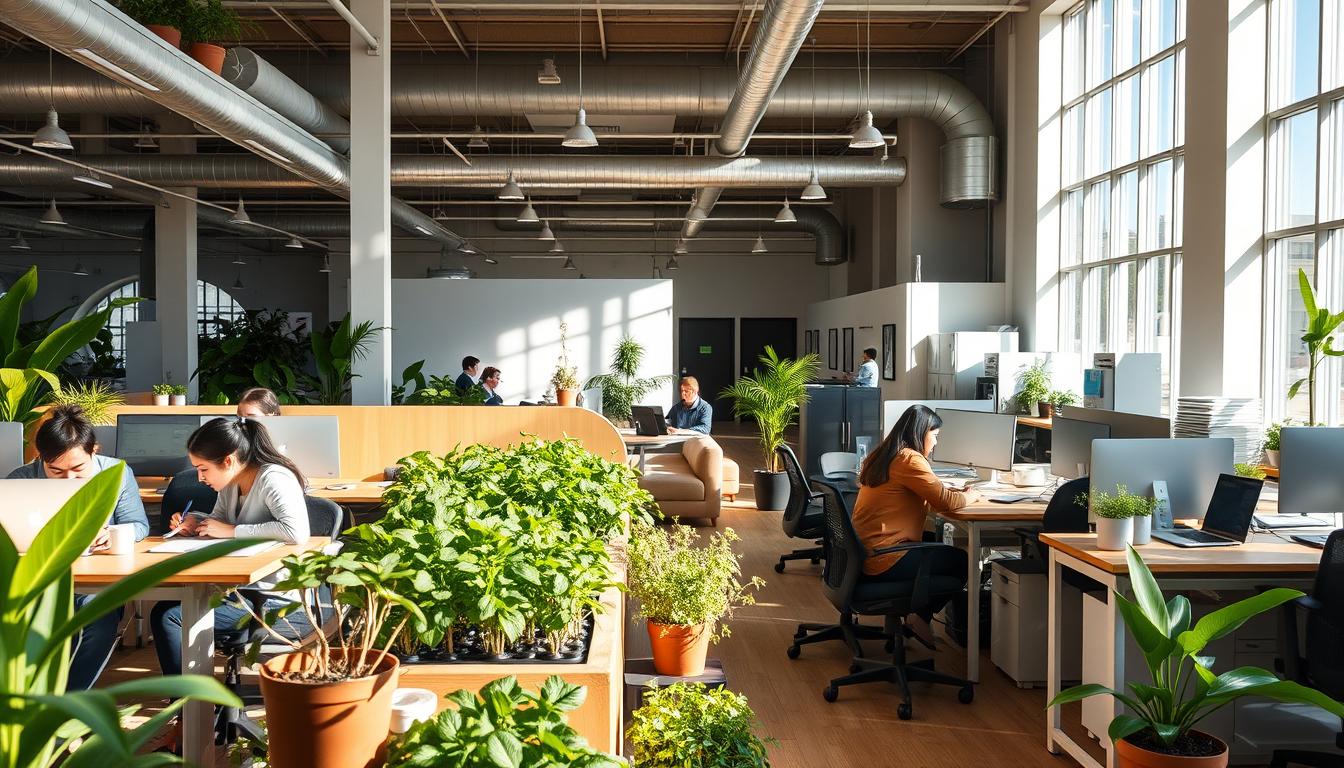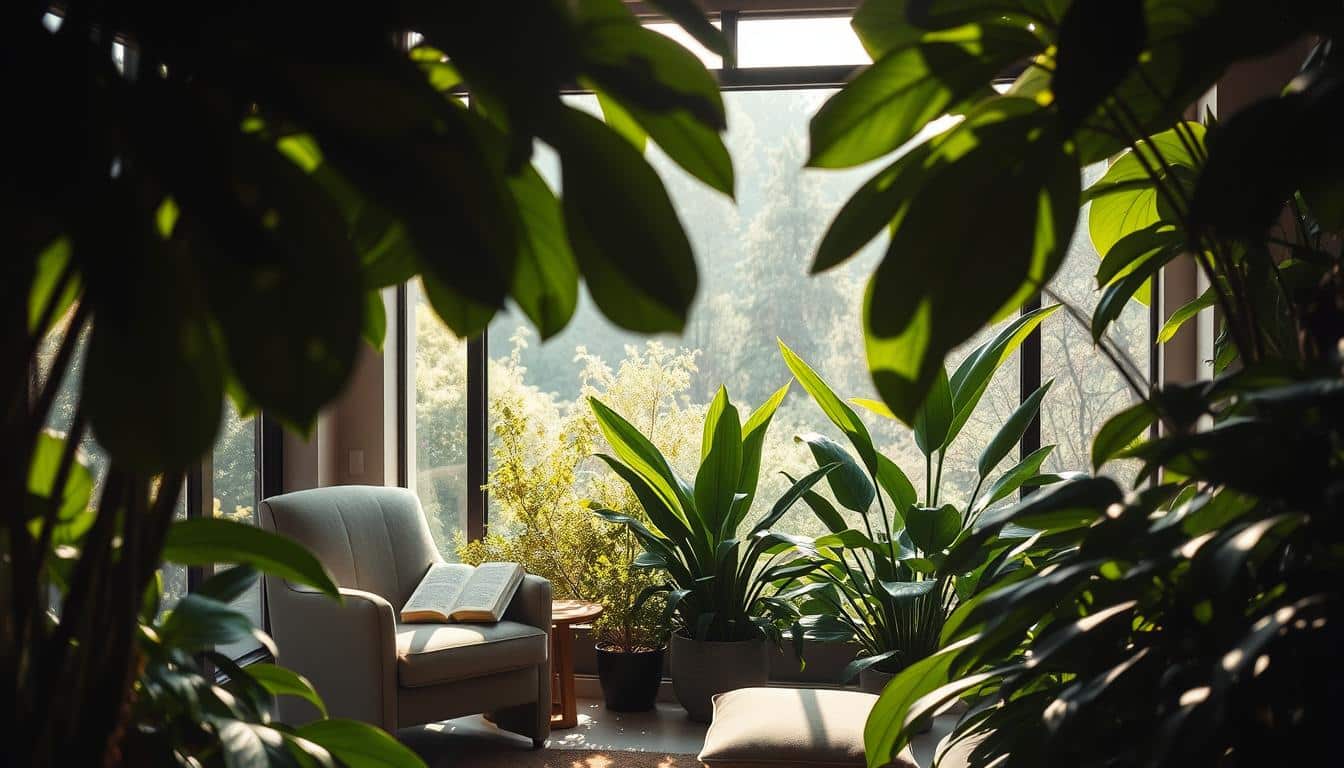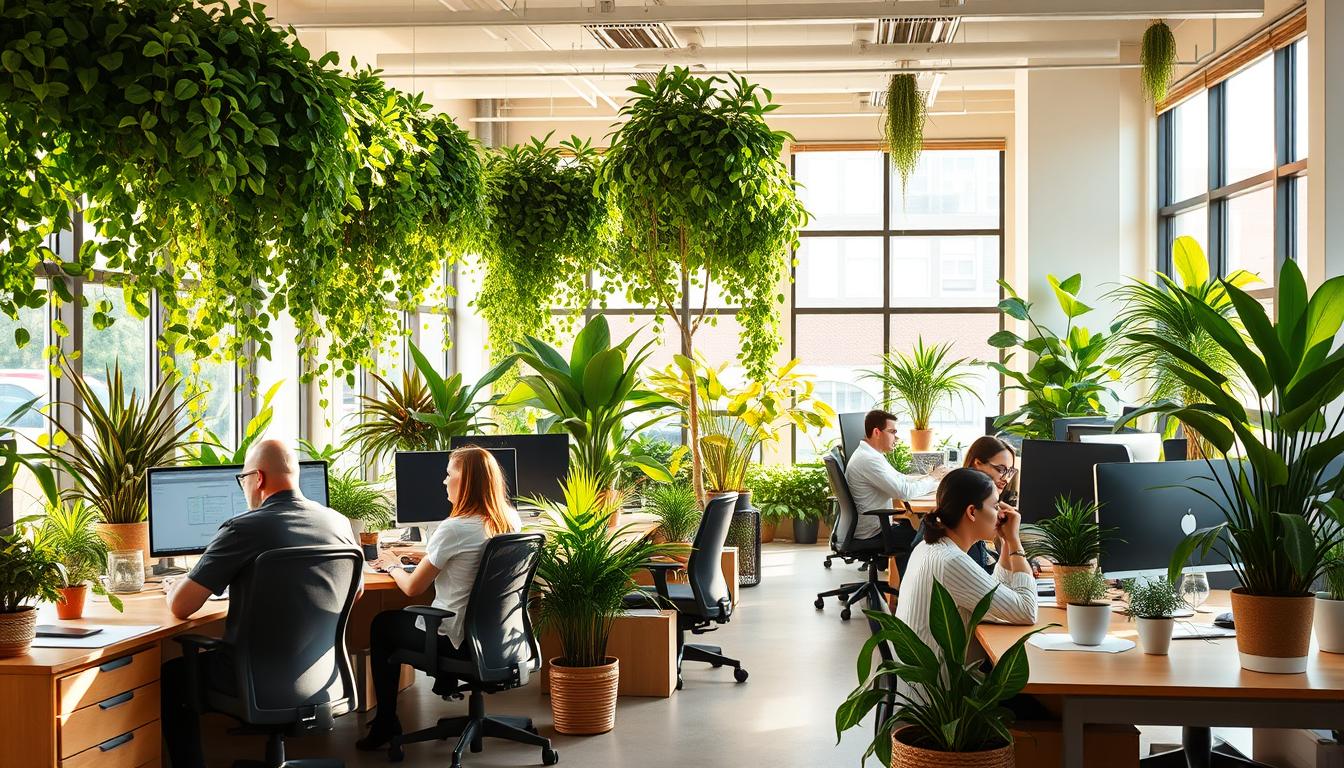In today’s fast-paced corporate scene, making stress-free workspaces is really important. Smart office layouts help boost employee happiness and work output. Companies that care about their team’s environment know they need to support different ways of working. This creates a vibe of teamwork and fresh ideas.
Using smart design tips, businesses can make their staff happier. This also helps the company make more money.
The Importance of a Stress-Reducing Workspace
The place where we work greatly impacts our happiness and how much we get done. A workspace that keeps stress low is key to feeling good and working well. Studies show that making the workplace calm can greatly improve how satisfied employees are, with happiness levels rising from 56% to an incredible 94%.
Having clean air, good lighting, and comfy furniture helps a lot in cutting down stress. Better air means we can focus more. Natural light makes the area brighter and lifts our spirits. And having furniture that’s good for our bodies keeps us healthy for a long time.
These things also help employees do their jobs better. A workspace that doesn’t stress us out makes everyone more involved. This leads to doing more and better work. Companies that pay attention to how their workspaces are set up are seen in a better light. This is good for both the people who work there and the company’s aims.

Understanding Employee Needs for Productivity
Knowing what employees need is key to a productive office. People work differently and what helps one person may not help another. While some like working together with lots of noise, others need quiet to focus.
When companies understand these needs, they can make better workspaces. They look at things like how noisy it is, the light, and how the office is set up. Happy workers are often more committed because their work style is supported.
Characteristics of Stress-Reducing Workspace Environments
Creating a stress-reducing workspace is all about knowing what employees need. By adding areas for group work and solo work, companies can boost productivity and cut down on stress.
Collaborative Spaces
Collaborative spaces help employees work together better. They’re made to encourage teamwork and sharing ideas. These areas have:
- Open layouts that make talking easier
- Comfy places to sit and talk
- Technology for sharing ideas and working on projects together
Focused Work Zones
For work needing a lot of focus, there are quiet areas. These places help employees think better and work without interruptions. They offer:
- Soundproofing to keep noises out
- Ergonomic furniture for comfort when working long hours
- Good lighting to keep eyes from getting tired and make the space welcoming
The Impact of Workspace Design on Employee Satisfaction
The design of a workspace is key to employee happiness. A good office setup that allows choice improves the work vibe. Workers with freedom to pick their work spot tend to be more involved and happier.
Addition of Nature in workspaces boosts employee health. Greenery and sunlight make offices more welcoming and help workers do more. Proper sound design also helps by reducing distractions.
A layout promoting teamwork and private work makes employees feel appreciated. This balance enhances both group and solo performance. A thoughtful workspace lowers stress and ups work output, crucial for a company’s success.
Incorporating Natural Elements into Office Design
Adding nature to office design can make the space better. Using indoor plants and lots of natural light helps a lot. These things make the office nice and help people work better.
Benefits of Indoor Plants
Indoor plants are great for more than just looks. They clean the air, lower stress, and make people feel calm. A study showed that offices with plants see less absences and happier staff. Plants make the work area look good and help everyone feel better mentally.
Using Natural Light and Views
Natural light is very important for a nice office. It makes people feel better and work more efficiently. Open layouts and big windows that let people see outside connect them to nature. This makes the office a better place to work.
Color Psychology in Workspace Design
Color psychology greatly influences how we design workspaces. It’s about how colors affect our feelings at work. A thoughtful choice of colors can make the office feel inviting. This helps everyone feel motivated and get more done.
Calming colors like blue and green make a place perfect for concentration. On the other hand, bright colors like yellow can spark creativity and clear thinking.
It’s important to pick the right colors based on how you want people to feel. The perfect mix can lessen stress and make workers happier. By creating areas with different colors, people can pick what suits their work best.
Using color psychology in your office design can really boost how happy and productive people are.
Noise Reduction Strategies for a Peaceful Work Environment
Making the workplace calm is key for better productivity and keeping employees happy. It’s important to use noise reduction methods to make the workplace quiet. Tackling outside noises can be done with soundproofing tools. Also, creating areas for quiet helps increase focus and relaxation.
Soundproofing Options
Here are some ways to keep noise down:
- Acoustic panels in work areas help soak up sound.
- Adding carpets or rugs cuts down on noises from walking and moving around.
- Choosing windows with two layers of glass blocks outside noise.
- Sound-masking systems play soft background sounds to cover up disruptive noises.
Creating Quiet Zones
Setting up quiet areas in the office helps with concentration. These spots need to be away from busy places and come with:
- Cozy seats for work or rest.
- Rules to keep things silent or talk softly to keep it quiet.
- Simple decor for a peaceful vibe.
Organizational Techniques to Minimize Stress
Organizing well is key to reducing stress and boosting productivity. A good filing system lets employees find documents easily. This saves time and lets them focus on their work. Also, keeping the workplace tidy makes everyone happier and work more smoothly.
Creating a Systematic Filing Method
A solid filing system changes how we handle information at work. Try these strategies:
- Use clear labels for folders and documents.
- Sort files by category, project, or what’s most important.
- Take time to throw out old stuff regularly.
- Go digital to cut down on paper.
Clutter Reduction Tips
Making your workspace look good helps clear your mind. Use these tips for a neat space:
- Clear your desk every day, keeping only what you need.
- Have specific places for papers and supplies.
- Get everyone to keep their desks clean.
- Use bins and shelves to stay organized.
Creating Stress-Reducing Workspace Environments
To create a less stressful workspace, focus on a design that puts employee needs first. You can use different strategies to make the workplace better and more relaxing. It’s about adding spaces for working together and private areas to concentrate.
Adding plants and plenty of natural light can make the office calmer. These things look good and help with mental health. The colors around the office can also lift spirits, making it important to pick the right ones.
Organizing the workspace well can reduce stress. Keep areas free of clutter and use smart storage to help team members stay focused and less distracted. Taking on workplace stress makes a healthier environment where employees thrive and are more involved.
Conclusion
Making a workspace that lowers stress is very important. It changes how employees feel while they work. Using smart design helps people work better and be happier. It also makes a strong culture that cares about health.
A nice workspace does more than look good. It makes people feel they belong and work well with others. It also helps them concentrate on their own. Such places are key in keeping businesses at the top of their game.
Looking ahead, we see that less stressful workspaces are a must. They are vital for companies that want to succeed. Focusing on the health of employees means creating workplaces that are full of life, innovation, and have less stress.



